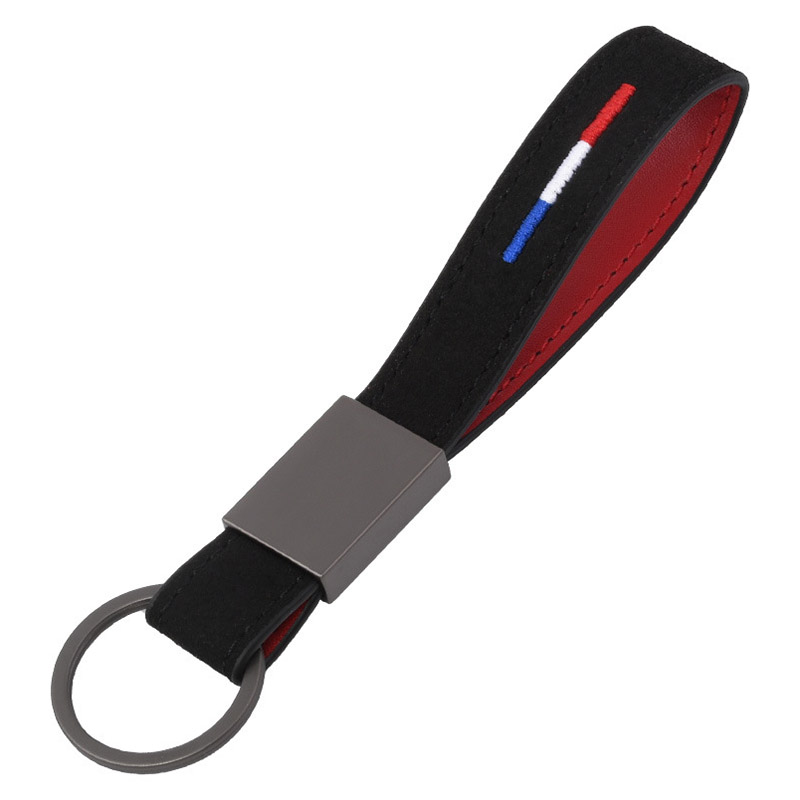Customizing Small Leather Keychains represents a unique intersection of practical utility and personal expression. This craft combines traditional leatherworking techniques with modern customization methods to create functional art pieces that serve both practical and aesthetic purposes. The process involves transforming high-quality leather materials into personalized accessories through various techniques including tooling, dyeing, stamping, and finishing.
The appeal of customized leather keychains lies in their ability to merge durability with personal significance. Unlike mass-produced alternatives, Custom Keychains can incorporate specific design elements, meaningful inscriptions, and unique color combinations that reflect the owner's personality or commemorate special occasions. The tactile quality of leather, combined with the craftsmanship involved in customization, creates items that develop character over time through natural aging and patina development.

Premium Leather Keychains typically utilize full-grain leather with thickness ranging from 2-3 oz (0.8-1.2mm), providing optimal durability while maintaining flexibility. The leather density averages 0.25-0.35 g/cm³, ensuring longevity without excessive bulk. Vegetable-tanned leather remains the preferred choice for customization projects due to its excellent impression retention capabilities and natural aging characteristics.
Modern customization techniques achieve impressive precision levels, with laser engraving capable of resolutions up to 1000 DPI and minimum line widths of 0.1mm. Traditional tooling methods maintain feature sizes as small as 1mm with depth control within 0.5mm. Color application through dyeing provides coverage of 95-98% with penetration depths varying from 0.1-0.3mm depending on leather porosity and dye viscosity.
Custom keychains demonstrate exceptional durability with tensile strength ratings between 15-25 MPa and tear resistance of 40-60 N/mm. The hardware components, typically brass or stainless steel, feature breaking strengths exceeding 50 kg and corrosion resistance tested to 100+ hours in salt spray testing. Stitching, when present, utilizes bonded nylon or polyester thread with tensile strengths of 8-12 lbs per stitch.
Protective finishes provide water resistance with contact angles measuring 100-120 degrees and moisture absorption rates below 5% after 24-hour exposure. UV-resistant coatings maintain color stability for 500+ hours in accelerated weathering tests. The surface hardness typically ranges from Shore A 60-80, providing scratch resistance while maintaining the characteristic leather suppleness.
Businesses increasingly utilize custom leather keychains as premium promotional products. The corporate application involves imprinting company logos with dimensional accuracy of ±0.15mm and color matching within ΔE<3 of brand standards. These items serve as tangible brand ambassadors with typical usage lifespans of 3-5 years, significantly outperforming cheaper alternatives in terms of perceived value and retention rates.
Custom keychains function as meaningful personal accessories for commemorating special events including anniversaries, graduations, and milestones. The personalization process accommodates intricate designs with minimum feature sizes of 0.5mm and supports various customization methods including debossing, foil stamping, and hand-painting. These pieces often incorporate significant dates, initials, or symbolic elements with positioning accuracy within 0.2mm.
Beyond decorative purposes, customized keychains serve practical organizational functions. The standard keyring opening diameters of 25mm accommodate multiple keys while maintaining secure closure with spring tension ratings of 2-4 N. Additional functional elements such as small pockets can integrate storage compartments with capacities up to 5ml, suitable for storing emergency contact information, micro SD cards, or small emergency cash.
Various professions benefit from specialized keychain customization. Medical professionals often incorporate antimicrobial treatments with efficacy rates exceeding 99.9% against common pathogens. Outdoor enthusiasts prefer water-resistant versions with waterproof ratings of IPX7 and enhanced UV protection. Security personnel utilize reinforced constructions with additional stitching and hardened metal components meeting impact resistance standards of IK07.
Implement a systematic cleaning regimen using pH-balanced leather cleaners with alkalinity levels between pH 6-8. Apply cleaning solutions using soft, lint-free cloths with pressure not exceeding 0.5 kg/cm². For deeply embedded dirt, use specialized leather cleaning brushes with bristle density of 1500-2000 bristles per square inch. Always perform cleaning at ambient temperatures between 15-25°C with relative humidity below 65%.
Leather conditioning should occur every 3-6 months depending on environmental exposure. Use conditioners containing natural oils like neatsfoot or mink oil with absorption rates of 85-95%. Apply in thin, even layers using circular motions, allowing 15-20 minutes for penetration before removing excess. The optimal application quantity is approximately 1ml per 100cm² of leather surface area. Conditioned leather should maintain moisture content between 14-18%.
Apply waterproofing and stain-resistant treatments every 6-12 months. Silicone-based protectors create surface tension of 35-45 mN/m, effectively repelling liquids while maintaining breathability. Spray applications should maintain a distance of 15-20cm from the surface, using overlapping passes with 50% coverage. Allow treated items to cure for 24 hours at temperatures above 10°C before use.
Store leather keychains in controlled environments with stable temperatures between 18-22°C and relative humidity maintained at 45-55%. Avoid direct sunlight exposure exceeding 50,000 lux for extended periods. Use breathable storage containers with air exchange rates of 1-2 air changes per hour. For long-term storage, include silica gel packets to maintain humidity below 40% and prevent mold growth.
Regularly inspect keychains for early signs of wear, paying particular attention to stitching integrity and metal component corrosion. Address minor scratches using specialized leather fillers with viscosity ratings of 800-1200 cP. For color restoration, use professional-grade leather dyes with pigment concentrations of 8-12% and particle sizes below 5μm. Professional repair is recommended when stitch density decreases below 4 stitches per cm or when cracking extends beyond 0.5mm in depth.